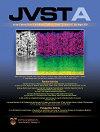氧等离子体处理TeO2-B2O3(硼碲酸盐)薄膜
IF 2.1
3区 材料科学
Q3 MATERIALS SCIENCE, COATINGS & FILMS
引用次数: 0
摘要
本研究采用传统熔淬法制备了75TeO2-25B2O3 (mol. %) (TB)的硼碲酸盐玻璃。随后使用热离子真空电弧系统将玻璃沉积成薄膜,并将一部分样品进行低压冷氧等离子体系统处理,形成“TBO(氧等离子体处理的硼碲酸盐)”薄膜。采用x射线衍射分析、x射线光电子能谱、拉曼光谱、场发射扫描电镜和原子力显微镜对TB和TBO薄膜的结构和形态特性进行了表征。采用紫外可见分光光度法在300 ~ 800 nm范围内对薄膜样品的光学性能进行了评价。采用四探针范德波法测量了薄膜的电阻率。发现TB薄膜具有非晶态结构,并有一些晶体形成,而TBO薄膜与文献中描述的块状硼碲酸盐玻璃相似,没有可检测到的晶体形成。TB和TBO薄膜表面均呈均匀和非晶态。此外,氧等离子体处理后薄膜的电子结构发生了变化。本文章由计算机程序翻译,如有差异,请以英文原文为准。
Oxygen plasma treatment of TeO2—B2O3 (boro-tellurite) thin films
In this study, boro-tellurite glasses with a composition of 75TeO2–25B2O3 (mol. %) (TB) were synthesized using a traditional melt-quenching method. The glasses were subsequently deposited as thin films using the thermionic vacuum arc system, and a subset of the samples underwent treatment with a low-pressure cold oxygen plasma system, resulting in the formation of the “TBO (boro-tellurite treated by oxygen plasma)” thin films. The structural and morphological properties of the TB and TBO thin films were characterized using x-ray diffraction analysis, x-ray photoelectron spectroscopy, Raman spectroscopy, field emission scanning electron microscopy, and atomic force microscopy. The optical properties of the thin film samples were evaluated using ultraviolet–visible spectrophotometry in the range of 300–800 nm. The resistivity of the thin films was measured using the four-probe Van der Pauw method. It was found that the TB thin films had an amorphous structure with some crystalline formations, whereas the TBO thin films were similar to the bulk boro-tellurite glasses described in the literature, with no detectable crystalline formations. Both TB and TBO thin films exhibited homogenous and amorphous surfaces. Furthermore, the electronic structure of the thin films has changed after oxygen plasma treatment.
求助全文
通过发布文献求助,成功后即可免费获取论文全文。
去求助
来源期刊

Journal of Vacuum Science & Technology A
工程技术-材料科学:膜
CiteScore
5.10
自引率
10.30%
发文量
247
审稿时长
2.1 months
期刊介绍:
Journal of Vacuum Science & Technology A publishes reports of original research, letters, and review articles that focus on fundamental scientific understanding of interfaces, surfaces, plasmas and thin films and on using this understanding to advance the state-of-the-art in various technological applications.
 求助内容:
求助内容: 应助结果提醒方式:
应助结果提醒方式:


